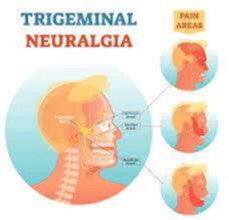The nurse is caring for a client diagnosed with trigeminal neuralgia. The client asks the nurse, "Why do I have so much pain?" Which of the following responses by the nurse is most appropriate?
A "It's a local reaction to nasal stuffiness."
B "It's due to a hypoglycemic effect on the cranial nerve."
C "Release of catecholamines with infection or stress leads to the pain."
D "Pain is due to stimulation of the affected nerve by pressure and temperature.
The Correct Answer is D
Choice A Rationale: Linking the pain to nasal stuffiness is not an accurate explanation of trigeminal neuralgia.
Choice B Rationale: Hypoglycemia is not typically related to trigeminal neuralgia.
Choice C Rationale: Releasing catecholamines with infection or stress is not the primary cause of trigeminal neuralgia.
Choice D Rationale: Pain is often due to stimulation of the affected nerve by pressure and temperature. This is a more accurate and relevant explanation for trigeminal neuralgia.

Nursing Test Bank
Naxlex Comprehensive Predictor Exams
Related Questions
Correct Answer is ["A","B","C","D"]
Explanation
Choice A Rationale: Understanding the expected physiological changes of Alzheimer's disease can help the caregiver better cope with the client's behaviors and needs.
Choice B Rationale: Teaching actions to reduce stress is important for both the caregiver and the client, as stress can exacerbate behavioral symptoms in Alzheimer's disease.
Choice C Rationale: Referring to available community resources can provide valuable support and assistance to both the caregiver and the client.
Choice D Rationale: Identifying a social support system is essential for the caregiver to have emotional and practical support while caring for a client with Alzheimer's disease.
Choice E Rationale: While medication administration is important, it may not be the primary focus of coping strategies for the caregiver.
Correct Answer is A
Explanation
Choice A Rationale: some medications that are used to calm down people with dementia can have serious side effects, especially for older adults. One of these side effects is an increased risk of experiencing a stroke, which can be life-threatening.
Choice B Rationale: Increased blood pressure can be a side effect of some medications used to calm patients with dementia, but it may not be the primary reason for not prescribing such medications. Furthermore, some medications can lower blood pressure, not increase it.
Choice C Rationale: Increased risk for infection is not typically a reason to avoid medications to calm dementia patients.
Choice D Rationale: is partially true because some medications can increase the risk for falls, but this is not the main reason why they are avoided.
Whether you are a student looking to ace your exams or a practicing nurse seeking to enhance your expertise , our nursing education contents will empower you with the confidence and competence to make a difference in the lives of patients and become a respected leader in the healthcare field.
Visit Naxlex, invest in your future and unlock endless possibilities with our unparalleled nursing education contents today
Report Wrong Answer on the Current Question
Do you disagree with the answer? If yes, what is your expected answer? Explain.
Kindly be descriptive with the issue you are facing.
